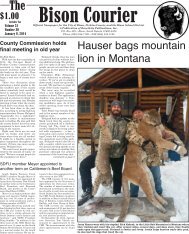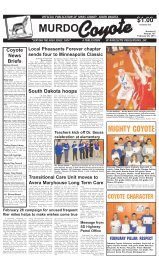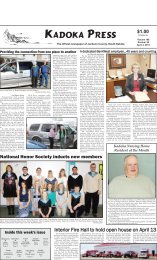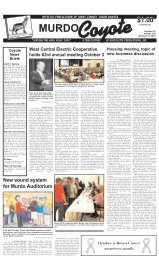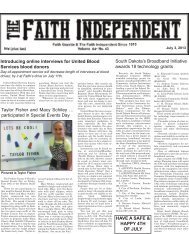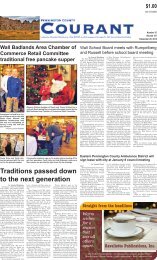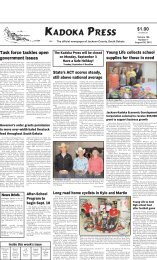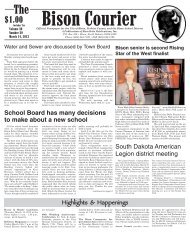Faith Independent - Pioneer Review
Faith Independent - Pioneer Review
Faith Independent - Pioneer Review
You also want an ePaper? Increase the reach of your titles
YUMPU automatically turns print PDFs into web optimized ePapers that Google loves.
Page 12• April 10, 2013 • The <strong>Faith</strong> <strong>Independent</strong><br />
Walt Bones to retire as<br />
Secretary of Agriculture<br />
South Dakota Secretary of<br />
Agriculture Walt Bones has announced<br />
plans to retire from his<br />
position, effective April 29. Bones,<br />
a Parker native, has headed the<br />
Ag Department since January<br />
2011.<br />
“It has truly been an honor to<br />
serve as Secretary of Agriculture,”<br />
Bones said. “I’ve served<br />
with a group of dedicated public<br />
servants – from the Governor,<br />
who really understands the role<br />
of agriculture, to his staff and<br />
Cabinet members, our Legislature,<br />
and especially Department<br />
of Agriculture employees, everyone<br />
has worked hard to promote<br />
and protect the best interests of<br />
our industry.”<br />
“I would like to thank all our<br />
farmers, ranchers and industry<br />
leaders who work every day to ensure<br />
the sustainability and viability<br />
of South Dakota Agriculture,”<br />
Bones said. “My number one<br />
takeaway from my time in public<br />
service is the amazing things we<br />
can accomplish when we all work<br />
together.”<br />
Governor Daugaard praised<br />
Secretary Bones for his service.<br />
“Walt Bones is a great leader<br />
in the ag community, and I have<br />
appreciated his hard work for<br />
South Dakota’s No. 1 industry,”<br />
the Governor said. “I thank him<br />
for his service to South Dakota<br />
and wish him well.”<br />
Bones is a partner in a family<br />
farming operation near Parker,<br />
and upon his retirement he will<br />
return to his farm.<br />
Place a Classified Ad...<br />
The <strong>Faith</strong> <strong>Independent</strong><br />
967-2160/email: faithind@faithsd.com<br />
Milk fever in beef cows<br />
Minerals are critical to the<br />
health and performance of grazing<br />
livestock. Deficiencies and excesses<br />
of minerals in an animal's<br />
diet can cause weight loss, decreased<br />
reproductive performance,<br />
and a variety of nutritional<br />
disorders, says Kalyn Waters,<br />
SDSU Extension Cow/Calf Field<br />
Specialist. She points to milk<br />
fever as a metabolic issue that<br />
can occur as a result of mineral<br />
imbalances this time of year.<br />
"It is important to understand<br />
various factors that contribute to<br />
the potential for these disorders<br />
and also to understand associated<br />
symptoms and treatments to minimize<br />
losses," Waters said.<br />
Milk Fever (Parturient<br />
Paresis)<br />
Milk fever is generally associated<br />
with high-producing dairy<br />
cattle; however, it can also occur<br />
in beef cattle Waters explains.<br />
"Milk fever is a result of<br />
hypocalcaemia (low calcium).<br />
Most forage contains enough calcium<br />
to meet the minimal requirements<br />
of livestock, which is<br />
around 40 grams per day. However,<br />
a dramatic increase in calcium<br />
requirements occurs with<br />
the onset of lactation in the dam,<br />
and requirements are typically<br />
unable to be met simply by increasing<br />
Calcium intake," she<br />
said.<br />
Colostrum which contains 2.0<br />
to 2.3grams per liter of calcium is<br />
partly to blame explains Waters.<br />
"Colostrum drains reserves in<br />
the cow's blood stream; which explains<br />
why milk fever is typically<br />
seen in mature cows as they have<br />
a much greater rate of colostrum<br />
production."<br />
Hypocalcaemia results in a decrease<br />
in smooth muscle function,<br />
decreasing rumen and gastrointestinal<br />
tract function and ultimately<br />
resulting in a decrease in<br />
dry matter intake. In addition,<br />
decreases in uterine motility and<br />
immunity raise the risk of uterine<br />
infections and decreased fertility.<br />
Normal levels of calcium in the<br />
blood will be between 8.5 and 11<br />
milligrams per deciliter (mg/dL);<br />
however, levels drop dramatically<br />
in a cow experiencing milk fever,<br />
resulting in clinical symptoms<br />
which can include; lack of muscle<br />
coordination and twitching; dry<br />
muzzle, depression, altered rectal<br />
temperature, and laying down<br />
but still up right; and in the most<br />
severe stage - bloat, laying out<br />
flat, weak pulse, flaccid muscles,<br />
risk of death. This decrease of calcium<br />
in the blood supply directly<br />
impacts the animal's ability to<br />
regulate muscle contractions and<br />
relaxation, which is the most<br />
identifiable clinical signs of milk<br />
fever.<br />
Waters says that cattle must<br />
be able to increase absorption of<br />
calcium in the small intestine and<br />
mobilize stored calcium from<br />
bones to effectively meet increased<br />
requirements of lactation.<br />
"Mobilization of bone calcium<br />
is regulated by parathyroid hormone<br />
(PTH), which is produced<br />
by glands in the neck. When blood<br />
calcium levels drop, PTH is activated.<br />
As this occurs, a secondary<br />
hormone derived from vitamin D<br />
in the kidney stimulates the intestine<br />
to increase absorption of<br />
dietary calcium. If calcium intake<br />
from the diet was sufficient prior<br />
to calving, mechanisms for stimulating<br />
calcium mobilization may<br />
not be stimulated," she said.<br />
Because of this, Waters recommends<br />
that cattle producers reduce<br />
calcium intake late in<br />
gestation to prime those systems<br />
and increase their functionality<br />
prior to the onset of lactation. She<br />
Ravellette Publications, Inc.<br />
Letters Policy<br />
Ravellette Publications is happy to receive letters concerning comments<br />
on any news story or personal feeling on any subject. We do reserve<br />
the right to edit any offensive material and also to edit to fill the<br />
allotted space. We also reserve the right to reject any or all letters.<br />
Our deadline for insertion in the Wednesday issue is the preceding<br />
Monday at 12:00 noon<br />
Letters intended for more than one Ravellette Publications newspaper<br />
should be mailed or hand delivered to each individual newspaper<br />
office. All letters must bear the original signature, address and telephone<br />
number of the author.<br />
POLITICAL LETTERS TO THE EDITOR: No political letters are to<br />
run the two weeks prior to an election.<br />
The “Letters” column is intended to offer readers the opportunity to<br />
express their opinions. It is not meant to replace advertising as a means<br />
of reaching people.<br />
This publication’s goal is to protect the first amendment guarantee<br />
of free speech. Your comments are welcomed and encouraged.<br />
The <strong>Faith</strong> <strong>Independent</strong> • P.O. Box 38 • <strong>Faith</strong>, SD 57626-0038<br />
(605) 967-2161 • FAX: (605) 967-2160<br />
admits however, it is difficult to<br />
get calcium levels in the diet low<br />
enough to actually prevent milk<br />
fever.<br />
Blood pH<br />
Another factor that can affect<br />
the ability of cows to mobilize calcium<br />
reserves from bone is pH<br />
level of the blood.<br />
"Calcium acts as a base in the<br />
blood, thus higher levels of calcium<br />
will result in more alkaline<br />
blood pH. If pH of cattle is too alkaline,<br />
hormones that stimulate<br />
PTH do not act efficiently on bone<br />
or kidney tissues and cattle are<br />
unable to mobilize calcium reserves,"<br />
Waters said.<br />
Waters says adequate levels of<br />
magnesium are also important in<br />
the function of these hormones. If<br />
magnesium is deficient, supplying<br />
magnesium chloride, magnesium<br />
sulfate, or magnesium oxide<br />
in the diet at a level of up to 0.4<br />
percent can help acidify the blood.<br />
Excessive potassium in the<br />
diet is one of the major factors affecting<br />
blood pH and potentially<br />
contributing to milk fever. Some<br />
types of forage may have excessively<br />
high amounts of potassium<br />
due to fertilization strategies and<br />
accumulation of potassium in<br />
plant tissues. Waters says that<br />
high levels of potassium may be<br />
observed in lush green grasses<br />
and alfalfa, while corn silage,<br />
straw and small grain forages<br />
tend to contain lower levels.<br />
If forages are suspect in milk<br />
fever cases, potassium concentration<br />
should be determined by<br />
standard "wet chemistry" lab<br />
analysis. To learn more about this<br />
analysis<br />
visit<br />
http://igrow.org/up/resources/02-<br />
1002-2012.pdf.<br />
Rations with less than 2 percent<br />
potassium are recommended<br />
to prevent milk fever.<br />
"Although mineral requirements<br />
are considered to be small<br />
in relation to other nutrients,<br />
they serve numerous important<br />
functions in animal health and<br />
immune response," Waters said.<br />
"Milk fever is an example of how<br />
complex mineral interactions and<br />
imbalances can cause metabolic<br />
issues, particularly in lactating<br />
animals with increased requirements."<br />
In cases of milk fever, Waters<br />
says early detection is key to successful<br />
treatment. Waters encourages<br />
producers to observe cattle<br />
closely to minimize losses, and<br />
producers should maintain close<br />
contact with their veterinarian<br />
for the best prevention and treatment<br />
strategies.<br />
For more information visit<br />
iGrow.org or contact Waters at<br />
the SDSU Extension Regional<br />
Center in Winner, 605-842-1267<br />
or kalyn.waters@sdstate.edu; or<br />
contact SDSU Extension Research<br />
Associate, Janna Kincheloe<br />
at the West River Ag. Center,<br />
605-394-2236 or janna.kincheloe@sdstate.edu;<br />
or contact any<br />
SDSU Extension Cow/Calf Field<br />
Specialist and Beef Extension<br />
Specialist. SDSU Extension staff<br />
contact information can be found<br />
at iGrow.org.



